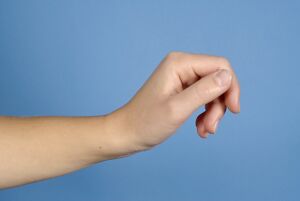Tenodesis Function in Spinal Cord Injury
Original Editor - Dr. Jennifer Dunne
Top Contributors - Naomi O'Reilly and Blessed Denzel Vhudzijena
Introduction[edit | edit source]
Tenodesis function occurs when the wrist is extended the fingers and thumb flex into the palm (Fig 1a) and then when the wrist is flexed the fingers and thumb open (Fig 1b). This function is used to facilitate grasp in people with tetraplegia who have wrist extension against gravity but no active finger function (C6 Motor Level), active wrist extension passively pulls the fingers and thumb into flexion. It is critical to gain tenodesis function to enable task performance as objects can be passively held between the thumb and index finger or in the palm.
Development of Tenodesis Function[edit | edit source]
Tenodesis function is fully dependent upon active wrist extension against gravity however, the process of development of tenodesis function is not fully understood. While SCI is commonly considered a condition of the central nervous system because of the damage to the upper motor neurons, it is not uncommon for concurrent lower motor neuron damage to occur at the level of the injury. Recent research demonstrates lower motor neuron damage at the level of the injury of finger extensors to be a strong predictor for development of tenodesis function. [1] Development of tenodesis function can be facilitated by:
- Constant monitoring of the hand and promoting correct tension in muscles and reducing spasticity that may impact the balance and function of the hand[2].
- Prevention of overstretching of the finger flexors in both passive movements performed by the therapist, and functional activities such as propping on extended wrists or transferring.
- Prevention of oedema in the hand.
- Education of person with tetraplegia on tenodesis grasp, use of splints, self-stretches.
Diverse splinting and taping strategies have been practiced, but no one strategy has yet proven to be superior in providing the desired tenodesis function.[3] Failure to develop tenodesis function generally results in a less functional hand. One of the common presentations is the intrinsic minus (claw hand).
References[edit | edit source]
- ↑ Bersch I, Koch-Borner S, Friden J. Electrical stimulation-a mapping system for hand dysfunction in tetraplegia. Spinal Cord. 2018;56(5):516.
- ↑ Tweedy S,Beckman E, Geraghty T, Theisen D, Perret C, Harvey L, Vanlandewijck Y. Exercise and sports science Australia (ESSA) position statement on exercise and spinal cord injury. Journal of Science and Medicine in Sport. 2017; Volume 20 (2): Pages 108-115.
- ↑ Harvey L. Principles of Conservative Management for a Non-orthotic Tenodesis Grip in Tetraplegics. J Hand Ther. 1996;9(3):238-242.







